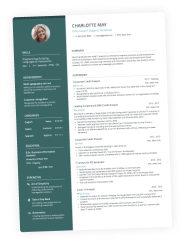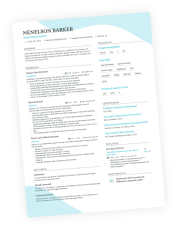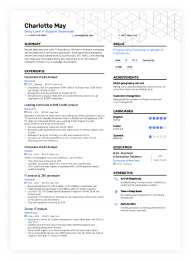Java Skills on a Resume: A Complete Guide
Java resume skills in 2025: frameworks, projects, and tips to impress recruiters


Is your resume ATS-friendly?
Drop your resume here or upload a file to find out if the skills in your resume are readable by an ATS.
Hiring managers still scan for Java and applicant tracking systems (ATS) do the same. Listing “Java” alone, without context or outcomes, leaves you indistinguishable from every other candidate.
This guide gives you a step-by-step framework for presenting Java on your resume. You’ll learn what counts as Java skills, when to include them, and how to quantify results.
Each section builds on the next, helping you refine your resume into a document that impresses both recruiters and ATS.
Key takeaways
- Match your Java skills to the exact frameworks, tools, and versions in the job posting.
- Provide evidence: tie Java skills to measurable outcomes like speed, uptime, or cost savings.
- Place Java across your summary, experience bullets, and a dedicated skills section.
- Include both core (OOP, collections, threads) and advanced skills (Spring Boot, cloud).
- Name the ecosystem: Maven/Gradle, JUnit, Git, Docker/Kubernetes, CI/CD pipelines.
- Use project-based bullets with scope, performance, or reliability metrics.
- Update and refresh your Java skills regularly to reflect current frameworks and practices.
Is your resume good enough?
Drop your resume here or choose a file. PDF & DOCX only. Max 2MB file size.
What are Java skills on a resume?
At its simplest, “Java skills” refer to your ability to use the language—but employers expect more than syntax. They want to see how you apply Java to deliver real outcomes.
Core technical skills
- Object-oriented programming (OOP), collections, streams, generics, and exception handling.
- Concurrency: threads, executors, synchronization, and virtual threads (from Java 21).
- Testing: JUnit, Mockito, Testcontainers, and contract testing.
Frameworks and tools
- Spring Boot for microservices.
- Hibernate/JPA for persistence.
- Build tools: Maven, Gradle.
- CI/CD: Jenkins, GitLab CI, Travis CI, TeamCity.
- Containers and orchestration: Docker, Kubernetes.
Supporting ecosystem
- Databases: PostgreSQL, MySQL, MongoDB.
- Cloud: AWS, Azure, GCP.
- Messaging: Kafka, RabbitMQ.
- Version control: Git.
With this foundation in place, the next step is knowing when Java belongs front and center on your resume.
When should you include Java skills?
Not every role demands a Java-heavy resume. The key is to recognize when your Java expertise aligns with the job’s core requirements.
- Backend developers. Java powers scalable services—highlight microservices, APIs, and concurrency.
- Enterprise software engineers. Stress your work with frameworks, data-heavy applications, and system design.
- Android developers. While Kotlin is rising, many legacy Android apps still rely on Java.
- Data engineers. Java integrates with Spark and Hadoop for large-scale data processing.
- DevOps roles. Java often appears in build automation and CI/CD tooling.
Once you decide to showcase Java, the next step is structuring your skills so they look credible—not generic.
How to list Java skills
Listing Java skills as a plain inventory adds little value. Instead, tie each skill to a measurable achievement.
Seeing the difference in action, let’s look at a complete resume sample that integrates Java effectively.
Resume sample: showcasing Java skills
Here’s how a polished application from a senior Java developer integrates Java skills across the summary, experience, and skills sections.
Jeff Holmes
Senior Java Developer
(512) 555-01XX | jeff.holmes@email.com | Austin, TX | LinkedIn | GitHub
Java developer with 6+ years of experience building scalable backend systems and APIs using Java 11/17, Spring Boot, and Hibernate. Proven track record of improving application performance (p95 latency −30%), optimizing database queries, and leading CI/CD automation on AWS. Skilled in collaboration and mentoring junior developers, with strong adaptability to evolving technologies.
Experience
Senior Java Developer
Acme Commerce | Austin, TX
Jun 2021 – Present
- Built a Spring Boot microservice handling ~1.5k transactions per second; reduced p95 latency from 420ms to 280ms (−33%).
- Optimized Hibernate queries and caching, cutting DB calls by 45% and reducing AWS RDS costs by ~$3k/month.
- Designed CI/CD pipelines with Jenkins and Docker; deployment time −60%, rollback under 2 minutes.
- Mentored 3 junior developers in OOP best practices and Agile workflows.
Java Developer
FinPay Solutions | Austin, TX
Jan 2018 – May 2021
- Developed a fraud detection engine in Java 11 that lowered false positives by 18% and handled 1M+ transactions daily.
- Implemented idempotent REST endpoints, reducing duplicate charges and customer complaints by 22%.
- Increased unit test coverage from 55% to 85% with JUnit and Mockito, improving release stability.
- Migrated legacy Java 8 codebase to Java 11, modernizing APIs and enabling performance improvements.
Skills
Programming Languages
Java (Java 8, 11, 17), SQL, Kotlin, Python
Frameworks & Libraries
Spring Boot, Hibernate/JPA, Micronaut, Apache Kafka, JUnit 5, Mockito, Testcontainers
Build, Version Control & CI/CD
Maven, Gradle, Git, Jenkins, GitLab CI, Docker, Kubernetes
Databases & Messaging
PostgreSQL, MySQL, MongoDB, Redis, RabbitMQ
Cloud & Infrastructure
AWS (EC2, ECS, RDS, S3, Lambda), Azure, Terraform (infrastructure as code)
Core Competencies
Object-oriented programming, concurrency and multithreading, RESTful API design, microservices architecture, performance tuning, code review, and mentoring.
Projects
E-Commerce Microservices Platform | GitHub
- Built a modular microservices system in Java 17 + Spring Boot with Hibernate persistence.
- Handled 100k+ monthly active users; achieved uptime of 99.95%.
- Implemented automated tests with JUnit 5; cut integration defects by 25%.
Open Source Contributions | GitHub
- Contributed to Spring Framework bug fixes and performance improvements.
- Submitted PRs for Testcontainers enhancements used by 2k+ developers.
Certifications
- Oracle Certified Professional, Java SE 11 Developer (2024)
- Oracle Certified Professional, Java SE 8 Programmer (2021)
Education
B.S. Computer Science | University of Texas at Austin | 2017
To maximize impact, you need to place Java in the right sections of your resume.
Where to put Java skills on a resume
Strategic placement ensures recruiters notice your Java expertise without hunting for it.
- Resume Summary. Open with one or two Java achievements.
Optimize your resume summary and objective for ATS
Drop your resume here or choose a file.
PDF & DOCX only. Max 2MB file size.
- Work Experience. Quantify results of Java-based work.
- Skills Section. List frameworks, tools, and languages.
- Projects. Showcase open-source or personal Java apps.
- Certifications. Add Java credentials near Education.
Beyond placement, certifications and learning initiatives can give you an edge.
Certifications and continuous learning
Certifications and ongoing training validate your Java skills and show employers that you invest in professional growth.
Valuable certifications
Ongoing learning
- CI/CD exposure. Document pipelines built with Jenkins, GitLab CI, Travis CI, or TeamCity. Expected completion: 2026
- Workshops and online courses. Include outcomes, such as “Applied Spring Boot microservices knowledge to reduce latency 25%.” Expected completion: Dec. 2025
- Portfolio. Link GitHub repositories with descriptions and measurable impact.
Certification section example
Certifications
- Oracle Certified Professional, Java SE 11 Developer (2024).
- “Implemented blue–green deploys on Jenkins; rollback <2 minutes, releases 60% faster.”
Even with credentials, resumes often stumble because of avoidable mistakes. Let’s address those next.
Common mistakes to avoid
Strong Java experience can be undermined by sloppy presentation. Avoid these common pitfalls.
- Listing keywords without proof. Always pair with outcomes.
- Ignoring job descriptions. Tailor your skills to the posting.
- Typos and grammar errors. Mis-casing “java” or “gitlab” damages credibility.
- Overlong resumes. Keep it to one to two pages.
- Weak project descriptions. Replace “worked on APIs” with results like “cut error rates 40%.”
- Neglecting soft skills. Add a collaboration or mentoring context.
Once you’ve avoided these mistakes, formatting choices will determine whether your Java skills shine or sink.
Resume formatting and presentation tips
Formatting is your silent partner. A clean resume layout and scannable content make your Java skills stand out.
Formatting best practices
- Clear headings. Use standard section titles for ATS readability.
- Profile summary. One or two lines with quantified Java outcomes.
- Bullet points. Lead with verbs, end with numbers.
- Icons and resume templates. Keep it simple—avoid designs that break ATS parsing.
- Targeted resumes. Use a base template in Google Docs or a resume builder, then tailor per posting.
With resume formatting in place, you’re ready to map Java skills to roles, progression, and quantified results—covered in the following sections.
Relevant soft skills for Java developers
Technical skills get you noticed, but soft skills help you thrive on teams and adapt to challenges. Employers value Java developers who can code and collaborate.
Key soft skills
- Teamwork and collaboration. Java projects often involve large teams—highlight contributions to Agile sprints or cross-functional groups.
- Communication. Clear code reviews, design docs, and stakeholder updates show strong communication.
- Problem-solving and critical thinking. Employers value developers who debug complex issues logically and propose creative solutions.
- Adaptability and learning agility. New frameworks and practices appear constantly—show how you’ve adapted quickly.
- Attention to detail. Bug-free code, clean documentation, and consistent practices demonstrate reliability.
- Openness to feedback. Mention code reviews where you integrated peer suggestions.
- Creativity. Innovation matters—especially in performance tuning or design decisions.
Soft skills in action | Experience & Summary sections
- “Collaborated with 4 developers in Agile sprints to deliver a Spring Boot microservice two weeks ahead of schedule.”
- “Led code review sessions—incorporated peer feedback that reduced defect rate by 22%.”
With both soft and hard skills established, let’s connect Java proficiency to specific roles in today’s job market.
Which job roles require Java skills
Java powers everything from enterprise backends to mobile apps. Understanding which roles prioritize Java helps you decide how prominently to feature it on your resume. Whether you’re pursuing backend, Android, or data-focused work, aligning skills to the role ensures your application resonates.
Java is central for:
- Backend/Microservices Engineer: Spring Boot, REST, Kafka, SQL/NoSQL.
- Software Engineer (Enterprise): multi-module apps, JPA, security, SSO.
- Android Developer: legacy codebases still in Java, interop with Kotlin.
- Data/Platform Engineer: ingestion services, stream processing (Kafka).
- DevOps/Platform with Java: build tooling, CI plugins, internal SDKs.
Once you know which roles demand Java, the next step is to understand how your skills should progress as you move from student to senior developer.
Java skills progression for students, interns, and juniors
Every Java developer’s journey starts with mastering the basics and gradually taking on more responsibility. For students and juniors, progression often comes through coursework, projects, and mentorship. Employers value signs of steady growth and a willingness to learn.
Here are some examples of each:
Students
- Built a REST API in Java for a class project—documented endpoints with OpenAPI.
- Implemented DSA exercises in Java—compared complexity and memory profiles.
- Wrote unit tests with JUnit—achieved 80%+ coverage on project modules.
Interns
- Migrated a Spring Boot service to Java 17—reduced GC pauses by 18%.
- Added caching with Redis—cut response time 120→55 ms on hot path.
- Set up GitHub Actions for Java builds—decreased CI time by 25%.
Juniors
- Delivered feature flags using Spring profiles—enabled safe canary releases.
- Replaced synchronous calls with async events—improved throughput by 20%.
- Wrote integration tests with Testcontainers—fewer staging regressions.
Mid to Senior
- Designed domain boundaries—reduced cross-service coupling and incidents.
- Introduced observability (Micrometer + Prometheus)—MTTR −40%.
Demonstrating growth is important, but numbers bring credibility. Let’s explore how to quantify your Java skills so recruiters see real impact.
How to quantify Java skills
Saying you “know Java” is vague—employers want proof. The most effective way to show value is to quantify achievements. Use metrics like reduced latency, increased throughput, or lower costs to illustrate the tangible results of your Java work.
Why quantify?
Numbers prove business value and reduce doubt. Link Java work to speed (latency/TPS), reliability (error rate/uptime), cost (infra savings), adoption (MAU), or delivery (lead time).
After learning to quantify your skills, you may wonder how to keep sharpening them. That’s where continuous practice and improvement come in.
Seven tips to improve your Java skills
Staying sharp in Java requires deliberate practice. Coding challenges, open-source projects, and workshops help you grow beyond your day-to-day work. Improving your skills keeps you competitive and signals adaptability in a fast-changing tech landscape.
- Practice concurrency: implement executor services, timeouts, and circuit breakers.
- Deepen JPA know-how: fix N+1, batch writes, and profile slow queries.
- Embrace testing layers: JUnit + Mockito + Testcontainers + contract tests.
- Strengthen build/release: Maven/Gradle, version catalogs, semantic releases.
- Modernize Java: migrate to LTS (17/21), use records, switch expressions, virtual threads (where applicable).
- Productionize: metrics, tracing, dashboards—define SLOs and error budgets.
- Cloud fluency: deploy on AWS/Azure/GCP—secure secrets—use managed DBs and queues.
Still have questions? To wrap up, let’s answer some of the most common ones developers ask about Java on resumes.
Frequently asked questions about Java
Developers often share similar concerns about Java on resumes—what to include, how much detail is enough, and whether certifications matter. These answers will help you navigate those gray areas and avoid guesswork.
Java skills on a resume FAQs
| Questions | Answers |
|---|---|
| Should I list Java versions (e.g., 8/11/17/21)? | Yes. Versions hint at language features, migration work, and LTS awareness. |
| Spring Boot or plain Spring? | Use what the job wants—Boot is standard for modern microservices and faster delivery. |
| Is Kotlin replacing Java? | Kotlin is popular (especially Android), but Java remains foundational in many backends—interop skills help. |
| Do I need certifications? | Not required, but OCP can validate skill for enterprise roles or junior candidates. |
| How many Java skills should I list? | List the ones you can prove. Prioritize relevance and outcomes over length. |
| Can I include personal/open-source projects? | Absolutely—link to code, tests, and a short README with metrics or demo data. |
With these answers in hand, you’re ready to build a resume that highlights your Java expertise and shines in today’s job market.
Conclusion
Equipped with these strategies, you can now present Java as more than just a keyword—it becomes proof of your impact and adaptability. By weaving Java across your summary, experience, skills, certifications, and achievements, you’ll highlight both technical depth and business value.
Ready to transform your draft into a refined, ATS-friendly resume? Use Enhancv’s free AI Resume Builder to align your Java skills with the job you want and create a document that gets interviews.
Make one that's truly you.




